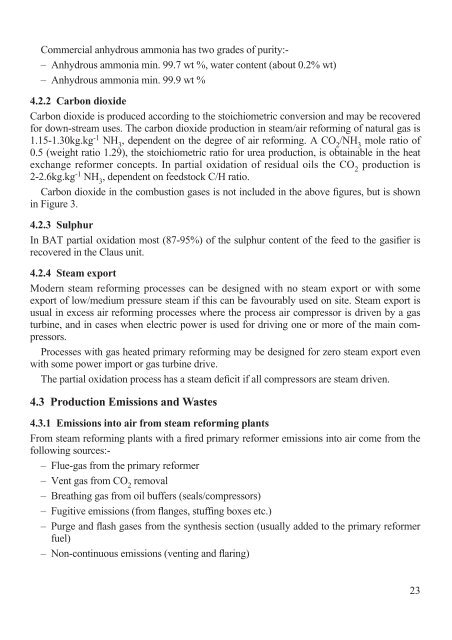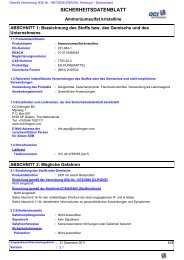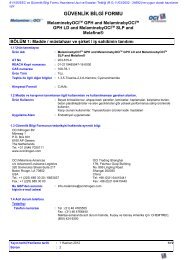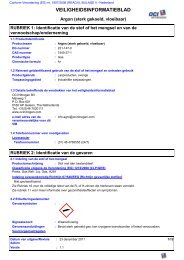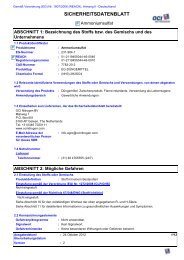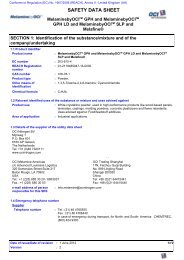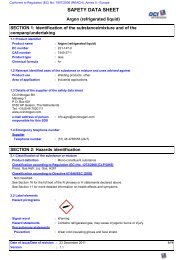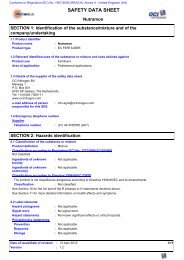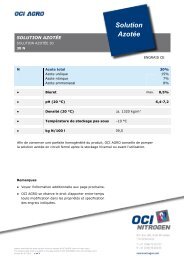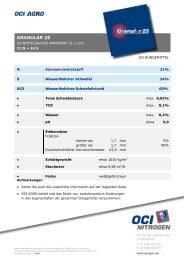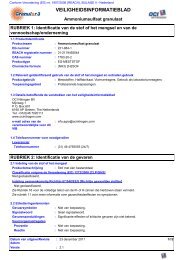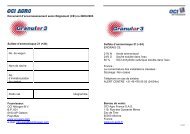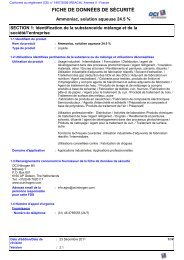PRODUCTION OF AMMONIA - OCI Nitrogen
PRODUCTION OF AMMONIA - OCI Nitrogen
PRODUCTION OF AMMONIA - OCI Nitrogen
You also want an ePaper? Increase the reach of your titles
YUMPU automatically turns print PDFs into web optimized ePapers that Google loves.
Commercial anhydrous ammonia has two grades of purity:-<br />
– Anhydrous ammonia min. 99.7 wt %, water content (about 0.2% wt)<br />
– Anhydrous ammonia min. 99.9 wt %<br />
4.2.2 Carbon dioxide<br />
Carbon dioxide is produced according to the stoichiometric conversion and may be recovered<br />
for down-stream uses. The carbon dioxide production in steam/air reforming of natural gas is<br />
1.15-1.30kg.kg -1 NH 3 , dependent on the degree of air reforming. A CO 2 /NH 3 mole ratio of<br />
0.5 (weight ratio 1.29), the stoichiometric ratio for urea production, is obtainable in the heat<br />
exchange reformer concepts. In partial oxidation of residual oils the CO 2 production is<br />
2-2.6kg.kg -1 NH 3 , dependent on feedstock C/H ratio.<br />
Carbon dioxide in the combustion gases is not included in the above figures, but is shown<br />
in Figure 3.<br />
4.2.3 Sulphur<br />
In BAT partial oxidation most (87-95%) of the sulphur content of the feed to the gasifier is<br />
recovered in the Claus unit.<br />
4.2.4 Steam export<br />
Modern steam reforming processes can be designed with no steam export or with some<br />
export of low/medium pressure steam if this can be favourably used on site. Steam export is<br />
usual in excess air reforming processes where the process air compressor is driven by a gas<br />
turbine, and in cases when electric power is used for driving one or more of the main compressors.<br />
Processes with gas heated primary reforming may be designed for zero steam export even<br />
with some power import or gas turbine drive.<br />
The partial oxidation process has a steam deficit if all compressors are steam driven.<br />
4.3 Production Emissions and Wastes<br />
4.3.1 Emissions into air from steam reforming plants<br />
From steam reforming plants with a fired primary reformer emissions into air come from the<br />
following sources:-<br />
– Flue-gas from the primary reformer<br />
– Vent gas from CO 2 removal<br />
– Breathing gas from oil buffers (seals/compressors)<br />
– Fugitive emissions (from flanges, stuffing boxes etc.)<br />
– Purge and flash gases from the synthesis section (usually added to the primary reformer<br />
fuel)<br />
– Non-continuous emissions (venting and flaring)<br />
23


